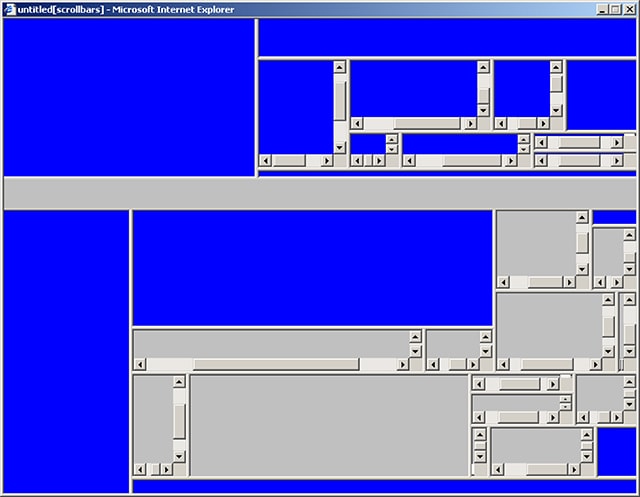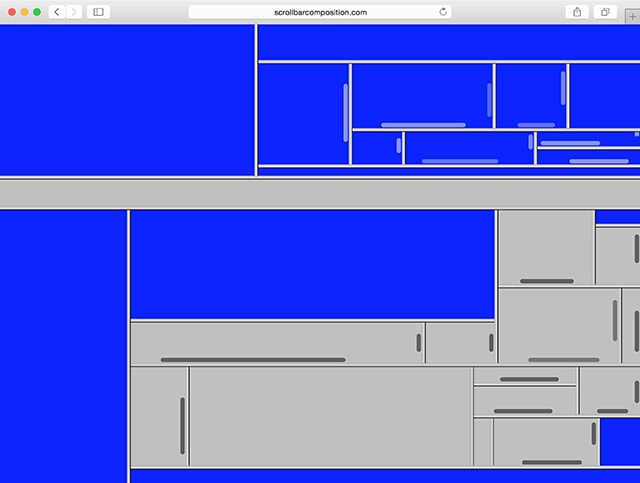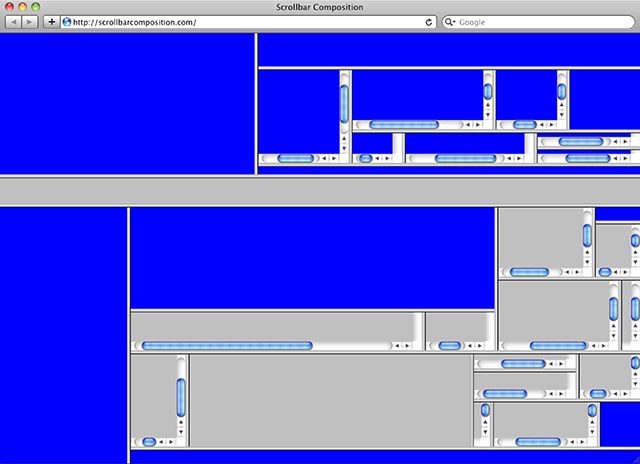title
Scrollbar Composition
artist
Jan Robert Leegte
intro
Scrollbar Composition (www.scrollbarcomposition.com, 2000) is a web-based artwork by Jan Robert Leegte. The web page is divided into planes by scrollbars, creating an abstract composition. The scrollbars move independently of a user and jump randomly in all directions.
The appearance of the artwork is dependent on the operating system and browser that is being used, and adapts to updates. The result is that Leegte’s scrollbars are in constant change which, in fact, makes the work performative. With this, Scrollbar Composition reflects on a key element of digital and net-based art: the volatility of digital materials due to the ever continuous updating of software and digital obsolescence. In the work, Leegte uses this to his advantage: the changing interfaces are an essential element of the piece.
Leegte uses typical elements of the digital interfaces of computer programs in his work, like scrollbars and mouse pointers, and places them in a new context. Scrollbar Composition has also been executed (translated) in different physical sculptures and installations, giving the virtual elements their own sculptural legitimacy.
The appearance of the artwork is dependent on the operating system and browser that is being used, and adapts to updates. The result is that Leegte’s scrollbars are in constant change which, in fact, makes the work performative. With this, Scrollbar Composition reflects on a key element of digital and net-based art: the volatility of digital materials due to the ever continuous updating of software and digital obsolescence. In the work, Leegte uses this to his advantage: the changing interfaces are an essential element of the piece.
Leegte uses typical elements of the digital interfaces of computer programs in his work, like scrollbars and mouse pointers, and places them in a new context. Scrollbar Composition has also been executed (translated) in different physical sculptures and installations, giving the virtual elements their own sculptural legitimacy.
biography artist
Jan Robert Leegte first studied architecture at the Technical University of Delft, before he switched to the Willem de Kooning Academy in Rotterdam where he studied fine arts and interaction design. Since 1997 he has been making art in the form of websites and was involved in the 90s net art movement. He also translates his online work into offline work such as sculptures, prints, or projections.
keywords
net art, internet art, scrollbars, browser, interface, website, post-internet
images
[caption id="attachment_386" align="alignnone" width="640"] Jan Robert Leegte, Scrollbar Composition, 2000.[/caption][caption id="attachment_387" align="alignnone" width="640"]
Jan Robert Leegte, Scrollbar Composition, 2000.[/caption][caption id="attachment_387" align="alignnone" width="640"] Jan Robert Leegte, Scrollbar Composition, 2000.[/caption][caption id="attachment_388" align="alignnone" width="640"]
Jan Robert Leegte, Scrollbar Composition, 2000.[/caption][caption id="attachment_388" align="alignnone" width="640"] Jan Robert Leegte, Scrollbar Composition, 2000.[/caption]
Jan Robert Leegte, Scrollbar Composition, 2000.[/caption]
 Jan Robert Leegte, Scrollbar Composition, 2000.[/caption][caption id="attachment_387" align="alignnone" width="640"]
Jan Robert Leegte, Scrollbar Composition, 2000.[/caption][caption id="attachment_387" align="alignnone" width="640"] Jan Robert Leegte, Scrollbar Composition, 2000.[/caption][caption id="attachment_388" align="alignnone" width="640"]
Jan Robert Leegte, Scrollbar Composition, 2000.[/caption][caption id="attachment_388" align="alignnone" width="640"] Jan Robert Leegte, Scrollbar Composition, 2000.[/caption]
Jan Robert Leegte, Scrollbar Composition, 2000.[/caption]
year
2000
premiere
The work was first published online in 2000.
software
HTML, Javascript, Browser
functionality
The work is different in various browsers and adapts to updates. Therefore it transforms continuously, which makes it a performative work.
It is possible to click and drag the scrollbars, but as soon as you release them they will start moving independently.
It is possible to click and drag the scrollbars, but as soon as you release them they will start moving independently.
part of collection
Stedelijk Museum Amsterdam / Stedelijk Museum Breda
Since November 2017, Scrollbar Composition can be seen in the permanent collection setup of Stedelijk Museum Amsterdam.
Since November 2017, Scrollbar Composition can be seen in the permanent collection setup of Stedelijk Museum Amsterdam.
production
The work has been made in Javascript in 2000 and hasn't been converted since.
hardware
Any device with an internet connection.
technical specs
intention artistquote by artist
quote
influence
Leegte says that he has been influenced by early net artists such as JODI, Martine Neddam, and Peter Luining. These net artists communicated and influenced each other using mailing lists, such as Rhizome and Nettime.
Leegte’s background in architecture has an evident influence on his work. He approaches the materiality of the internet as a sculptor and draws connections between digital interfaces and architectural elements such as ornaments.
In his work, Leegte often refers to art historical movements such as minimal art, land art, and conceptualism. From the start, he wanted to relate and respond to traditional art history. In 2002, Leegte started turning his online work into physical sculptures, installations, and projections. He is often labeled as a post-internet artist, not only making work on and for the web, but also translating it into offline art objects. (other Dutch post-internet artists include Constant Dullaart, Harm van den Dorpel, and Rafaël Rozendaal, among others.)
Leegte has recently participated in large international group exhibitions such as Electronic Superhighway at Whitechapel Gallery in London, and Open Codes at ZKM Karlsruhe. His works have been exhibited in venues such as Upstream Gallery, Stedelijk Museum Amsterdam, The Dutch Institute for Media Art, MAAT Lisbon, MOTI Breda, iMal Brussels, and Nomade Art Space in Hangzhou.
Leegte’s background in architecture has an evident influence on his work. He approaches the materiality of the internet as a sculptor and draws connections between digital interfaces and architectural elements such as ornaments.
In his work, Leegte often refers to art historical movements such as minimal art, land art, and conceptualism. From the start, he wanted to relate and respond to traditional art history. In 2002, Leegte started turning his online work into physical sculptures, installations, and projections. He is often labeled as a post-internet artist, not only making work on and for the web, but also translating it into offline art objects. (other Dutch post-internet artists include Constant Dullaart, Harm van den Dorpel, and Rafaël Rozendaal, among others.)
Leegte has recently participated in large international group exhibitions such as Electronic Superhighway at Whitechapel Gallery in London, and Open Codes at ZKM Karlsruhe. His works have been exhibited in venues such as Upstream Gallery, Stedelijk Museum Amsterdam, The Dutch Institute for Media Art, MAAT Lisbon, MOTI Breda, iMal Brussels, and Nomade Art Space in Hangzhou.
context
LITERATURE
Dekker, Annet. “Jan Robert Leegte: A Quest for Silence and Bewilderment in Minecraft's Vast Expanses.” AAAAN.NET, 8 Dec. 2013, aaaan.net.
Lorenzin, Filippo. “Sculpting the Internet | On Digital Materiality- Exhibition by Jan Robert Leegte.” Furtherfield, 4 Sept. 2016, furtherfield.org.
Vos, Lisa. “'HTML Is Mijn Steen En Beitel'.” NRC, NRC, 8 Sept. 2016, nrc.nl.
Lorenzin, Filippo. “Sculpting the Internet | On Digital Materiality- Exhibition by Jan Robert Leegte.” Furtherfield, 4 Sept. 2016, furtherfield.org.
Vos, Lisa. “'HTML Is Mijn Steen En Beitel'.” NRC, NRC, 8 Sept. 2016, nrc.nl.
part of active discussion
Online work does not require a museum to be introduced to the general public. As a result, the display of internet art in an institutional context has often been a matter of debate.1 One reason for this is that the experience of an internet artwork in a museum can differ greatly from the experience at home, behind your own laptop or computer. In a gallery or museum the artwork will, in any case, be drawn out of its original environment and transformed into an object or installation. In the context of a museum, such a work often does not function in the way it is meant to.
Because of this, Leegte began translating his online work to offline installations: a way to show his internet work in a physical context.
Because of this, Leegte began translating his online work to offline installations: a way to show his internet work in a physical context.
scene artists institutes
net art, Stedelijk Museum Amsterdam, W139, Smart Project Space, Mediamatic, Netherlands Media Art Institute, Peter Luining, JODI, Martine Neddam, Constant Dullaart, Rafaël Rozendaal, Harm van den Dorpel
footnote
1 For example, in the case of JODI’s work at documenta X. See: Josephine Bosma, Nettitudes: Let's Talk Net Art. (Nai 010 Publishers , 2011), p. 96.
Annie Abrahams
Livinus van de Bundt & Jeep van de Bundt
Driessens & Verstappen (Erwin Driessens and Maria Verstappen)
Yvonne le Grand
Edward Ihnatowicz
JODI (Joan Heemskerk & Dirk Paesmans)
Bas van Koolwijk
Lancel/Maat (Karen Lancel and Hermen Maat)
Jan Robert Leegte
Peter Luining
Martine Neddam
Marnix de Nijs and Edwin van der Heide
Dick Raaijmakers
Joost Rekveld
Remko Scha
Jeffrey Shaw
Debra Solomon
Steina
Peter Struycken
Michel Waisvisz